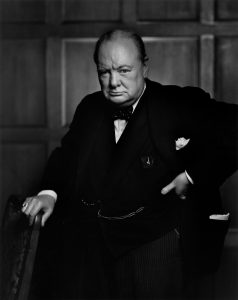
The famous picture was taken by a photographer in December 1941. It was taken by a thief exactly 80 years later. It was recovered last week when Ottawa police announced they had located the original print in Genoa, Italy.
A contemporary art collector had apparently purchased it, not realizing it had been stolen. He has now begun the process of returning the famous “Roaring Lion” photo of Winston Churchill to its rightful home at the Chateau Laurier Hotel in Ottawa.
“I didn’t know about the theft in Canada,” art collector Nicola Cassinelli told the media this week.
It’s a photograph I have long admired, not just because it depicts Churchill at the height of his career as a wartime prime minister of Britain, but because of the story behind it. Remember, December 1941 was one of the darkest periods of the Second World War, as Churchill attempted to manage a global war effort.
At the time, Hitler’s armies occupied all of northwestern Europe and North Africa, and were on the outskirts of Moscow (capital of our Soviet allies). Nazi U-boats were sinking hundreds of thousands of tonnes of British merchant shipping in the North Atlantic. And the Japanese had just overrun Hong Kong, Singapore and Pearl Harbor (which brought the U.S. into the war).
Churchill had prepared a defiant speech he would deliver to Canada’s Parliament just before New Year’s 1941-42.
“When I warned (the French) that Britain would fight on alone,” Churchill said in the House of Commons, “their generals (said), ‘In three weeks, England will have her neck wrung like a chicken.’” He paused, “Some chicken!” Then, he waited again through the thunderous applause for a second punch line, “Some neck!”
Immediately following Churchill’s oration in the Commons, Prime Minister Mackenzie King had invited his guest into the antechamber of the Speaker of the House, where teetotaler King sipped tea, while Churchill was given a glass of his favourite, Johnnie Walker Black Label whiskey.
It was at this moment, the two heads of state were greeted by photographer Yousef Karsh, who led the men into another room where he’d set up his lights and camera. Churchill wasn’t happy about having his picture taken but settled into a chair and lit his signature cigar.
Moments later, Karsh asked Churchill if he was ready, and the prime minister offered a slight smile.
But Karsh didn’t want a smile or the cigar. He leaned forward with something in his hand. “Sir, I have an ashtray all prepared for you.”
“No, thank you,” Churchill responded.
With lightning speed, Karsh grabbed the cigar from Churchill’s hand and snapped that now famous scowl. The “Roaring Lion” portrait was now history.
Then, sometime between Christmas Day 2021, and Jan. 6, 2022 – as Canada was locked down during the COVID-19 outbreak and the Chateau Laurier remained largely empty – a thief managed to steal the original print and replace it with a fake. Apparently, a hotel employee and also CBC News reporter Paul Hunter helped bring attention to the portrait which suddenly seemed altered.
Ottawa authorities began a global hunt, ultimately tracking down the stolen print in Italy. Acting Detective Akiva Geller announced on Sept. 11, that they’d arrested a man from Powassan, Ont., back in April. A publication ban had prevented police from announcing they’d retrieved the portrait and charged a man with theft, forgery and trafficking of stolen property.
Geller admitted it was “the most complicated and extensive investigation,” involving forensic analysis, tips from the public and support from international organizations, he’d ever experienced.
One might wonder why the print of a photo might become so sought after, indeed the object of an art thief’s scheming. Well, one reason is that when photograph Yousef Karsh died in 2002 all the negatives of his famous portraits went to Library and Archives Canada, where apparently his estate stipulated that no other prints will ever be printed.
So, now back to the “Roaring Lion” portrait. If you visit the Chateau Laurier one day, you’ll see it again in its rightful place off the main lobby. Of course, it shows the then leader of the free world, with that magnificent scowl captured by Karsh. His right hand rests prominently, as if ready to propel the man into action, on the armchair.
Meanwhile, his left hand has brushed back his suit jacket revealing his vest and expansive waist. Now, look closer still. There in his outside jacket pocket protrude several sheets of script. Of course, they contain the famous “Some chicken. Some neck” speech that he’d just delivered so eloquently to Canada and the world just minutes earlier.
Some portrait. Some story.